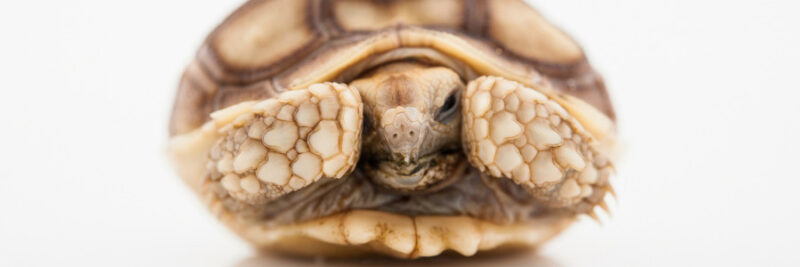Well howdy reptile lovers! Got a brand new baby sulcata tortoise arriving soon? So exciting! But fair warning – these adorable little tanks grow nearly as big as Volkswagons with appetites to match. So I wanna make sure you know what you’re getting into carewise with these ancient giants.
My goal today is setting you up for success by covering the enclosure, heating, diet and enrichment fundamentals needed to keep your sulcata thriving for decades to come. Sound fun? Then let’s do this!
Housing Sulcatas - Now and For the Long Haul

Even pint-sized hatchling sulcatas need serious space due to their restless natures and heavy grazing habits. Here are some size guidelines as they grow:
- Babies – minimum 24 x 48 inch enclosure
- Juveniles under 1 foot – 48 x 96 inch enclosure
- Adults over 1 foot – 800+ square feet minimum!
Yep, no tiny tortoise tables here! Sulcatas relish opportunities to wander and nibble in captivity as they might across African savannas. So creative DIY conversions of entire rooms or sheds is ideal to offer engaging spaces supporting healthy muscle growth and mental stimulation.
Now let’s talk temperature and lighting needs…
Keeping Your Sulcata Warm and Well-Lit
Recreate the hot 110F temps of their African homes by providing:
- A hot basking zone around 100F
- Ambient temps tapering down to 80F mid-enclosure
- Nighttime temps no lower than 75F
- Desert UVB 10.0 bulbs are a must
Use overhead ceramic heat emitters, radiant heat panels and linear UVB bulbs dialed into quality thermostats to maintain gradients.
Hatchlings should get 12-14 hours of bright overhead lighting while juveniles and adults only need ambient day lengths.
Keeping Your Sulcata Well-Fed

Get ready to buy kaytee timothy hay by the bale! Sulcatas graze near constantly in captivity to fuel their rapid growth. Provide:
- Unlimited grass hay and mixed greens always
- Rotating high fiber produce like kale and squash
- Occasional cactus pads, hibiscus flowers and prickly pear
Sprinkle meals 2-3 times weekly with calcium and multivitamin powders to prevent bone and shell abnormalities down the road.
And don’t forget a shallow water tub for hydration!
Bonding with Your Young Sulcata
While most tortoises aren’t cuddly pets, hatchlings and juveniles bond more closely through gentle daily handling like:
- Brief basking sessions on your lap
- Gentle shell scratches
- Hand feeding favorite greens
- Soaking in warm water baths
Limit sessions to 30 minutes max and avoid pulling limbs/head inside shell. Just be consistent and move slowly – they’ll warm up!
Monitoring Sulcata Health

Stay vigilant for these common health issues in captives:
Respiratory infections – wheezing, bubbly eyes/nose
Shell infections – foul odors, peeling scutes
Overgrown beak/nails – misshapen beak, curled nails
Have an exotic vet show you how to administer injections and dilute medications if needed. Prevent problems by keeping enclosures clean, dry and pest free.
Frequently Asked Questions About Beginner Sulcata Care
Alright, let's wrap up with some key FAQs:
Rotate small amounts of vegetables like kale, carrots, squash and sweet potato. Citrus fruits, melon, cactus, hibiscus flowers and mulberry leaves also offer nice diversity.
Offer multiple basking spots, hides, novel foods placed around enclosure, a dig box, and scent trails from lavender/herbs to investigate. Handle gently but consistently when emerging to build trust.
Have injectable antibiotics, oral antifungals, nasal flushes, vitamin supplements and pediatric syringes/needles from your exotic vet before issues arise.
Sulcatas are best kept indoors only for their first 1-3 years until reaching 6-12 inches length. Outdoor pens need buried fencing and secure climatic protection until they're over 18 inches length minimum.
Well I hope this 101 intro gets y’all off on the right foot – uh, make that claw – with your precious hatchling sulcata tortoises! Remember, an ounce of prevention is worth a pound of cure. So focus on nailing the habitat foundation first and the rest follows more smoothly. Now go enjoy those precious pyramiding-free years while they last! Let me know if any other questions pop up!

